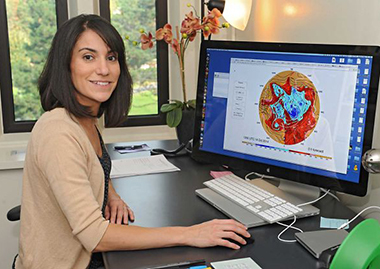Closing the Forecast Gap
 |
|
Atmospheric scientist Andrea Lang is part of a new National Oceanic and Atmospheric Administration task force seeking vastly improved weeks-long and months-long weather forecasting. |
ALBANY, N.Y. (October 3, 2016) — Though we may grouse at times, we know that forecasters do a very good job of giving us the coming week’s weather. Likewise, atmospheric science models are ever-improving the ability to predict climate time scales on the order of years.
Not so with that in-between time. Models that skillfully forecast what’s coming in the range of weeks to month — known as the sub-seasonal to seasonal, or S2S, time scale — have until recently been few, leaving a forecasting gap that can frustrate the plans of public and private sector forecasters, and industries such as agriculture, construction and energy.
S2S models are now appearing, and the National Oceanic and Atmospheric Administration (NOAA) wants to know how they can best be evaluated and improved upon. At the hub of this investigation is Andrea Lang, assistant professor of Atmospheric and Environmental Sciences.
She was recently named to the four-person leadership team of NOAA’s Subseasonal to Seasonal Prediction Task Force, comprising more than 50 atmospheric scientists from leading North American universities and research laboratories. Collectively, they are charged with closing the prediction gap.
In addition to Lang’s leadership role, which includes working with NOAA to coordinate data and information sharing as well as meetings among Task Force members, she and her UAlbany research group is contributing her own research on the impact of variability in the stratospheric polar vortex upon S2S forecasting.
During winter in the Northern Hemisphere, stratospheric polar vortex variability can be linked to extreme weather and climate, such as cold air outbreaks and changes in winter storm tracks that can impact the U.S., Europe and Asia. When this phenomenon is skillfully predicted by a forecast model, it will provide valuable information for the planning purposes of both private and public sectors.
“However, there is a gap in our understanding of the skill, uncertainty and biases in forecasts of stratospheric polar vortex variability that is currently a source of confusion for decision makers,” said Lang. “This research will help identify when we might have a good forecast and when we might have a bad forecast of the vortex variability.”
Lang’s research project will fund two students. The one named to this point, second-year graduate student Jonathan Blufer, is now supporting her work by conducting a case study of the polar vortex forecast from the winter of 2012/2013.
Lang and Blufer will be presenting preliminary results from this research at the American Meteorological Society's Annual Meeting in Seattle this January.
![]() For more news, subscribe to UAlbany's RSS headline feeds
For more news, subscribe to UAlbany's RSS headline feeds
A comprehensive public research university, the University at Albany-SUNY offers more than 120 undergraduate majors and minors and 125 master's, doctoral and graduate certificate programs. UAlbany is a leader among all New York State colleges and universities in such diverse fields as atmospheric and environmental sciences, business, education, public health,health sciences, criminal justice, emergency preparedness, engineering and applied sciences, informatics, public administration, social welfare and sociology, taught by an extensive roster of faculty experts. It also offers expanded academic and research opportunities for students through an affiliation with Albany Law School. With a curriculum enhanced by 600 study-abroad opportunities, UAlbany launches great careers.


